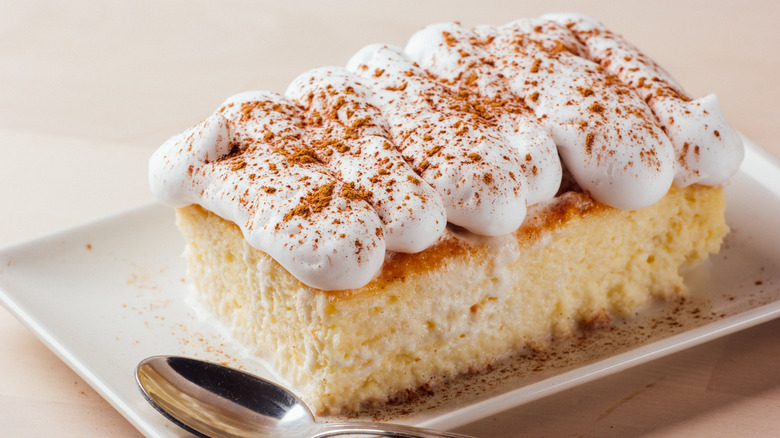The Tool Ina Garten Recommends For Ultra-Moist Tres Leches Cake
If you have a sweet tooth, chances are, you've indulged in many of the great cake flavors life has to offer. Whether you're a classic chocolate cake stan or you always opt for sweet vanilla, there's likely a cake out there to match just about anyone's preferences. However, we love to shed light on some of the world's more overlooked flavors — and one of those that deserves more time to shine is the always moist and delightful tres leches cake.
This super light and fluffy sponge cake gets its name from being soaked with three different kinds of milk: condensed milk, evaporated milk, and regular milk. These ingredients make this cake extra moist and easy to savor. Its sweetness often pairs well with fresh berries, which can be added as a topping along with whipped cream for an epic berries-and-cream flavor; cinnamon is also commonly sprinkled on top for a little hint of spice.
When it comes to perfecting this cake recipe, the queen of baking, Ina Garten, has some tips for you to keep in mind. One of the defining features of the cake is its ultra-moist texture. To ensure this critical feature is executed well, Garten shared the best step to take when baking a tres leches cake — and it involves a simple kitchen tool you probably already have on hand.
Don't be afraid to poke lots of holes
Before pouring milk over the tres leches cake to moisten it, Ina Garten uses the blunt end of a wooden skewer to puncture the cake's surface. Working in lines across the cake, she adds small holes that are barely noticeable, punching through the top of the cake until the skewer touches the pan. The entire sheet of cake is covered in tiny holes by the time Garten is finished with it, and there's an important reason behind why she does this, as she explained during a baking demonstration in Food Network's Youtube video.
As the milk is poured over the cake in an even layer, Garten notes that the holes let the dairy absorb better into the cake's core. The milk slowly seeps down through the tiny holes, and the cake soaks up the liquid in no time. She specifically uses the blunt end of the skewer so the incisions are slightly wider, allowing more milk to go down into the cake rather than leaving it to oversaturate the top while the bottom stays drier.
In the video, Garten remarks how amazing it is that so much milk is able to so quickly absorb into the cake while using this method. It certainly makes for a more evenly moist cake, so make sure to try out this tip at home the next time you bake this delightful treat for yourself.

